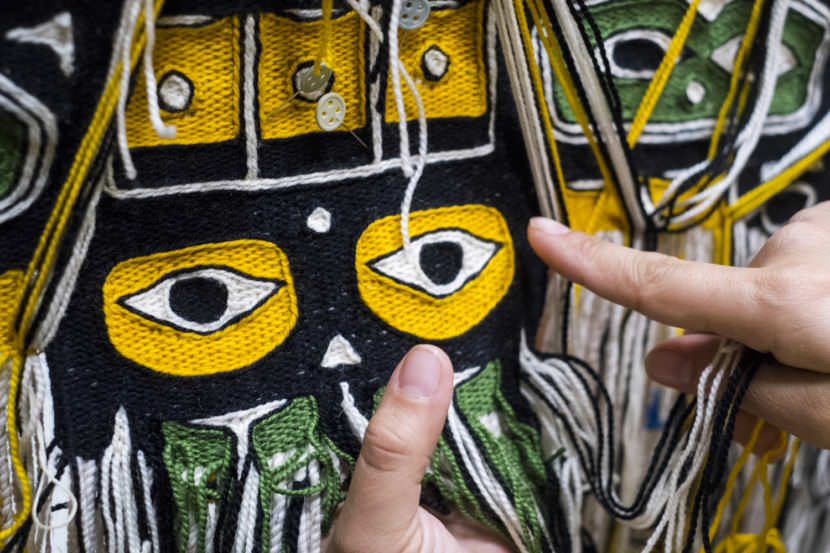
The Chilkat robes in the Alaska State Museum collections feature formline faces woven with yarn. The historic ceremonial garments combines once-vibrant yellows that have softened with age with warm black-browns and striking blues and greens.
Museum conservator Ellen Carrlee and her collaborators wanted to figure out where those classic pigments came from. The color curiosity evolved into Chilkat Dye Working Group, a collaboration between staff from museums in Washington, Oregon and Juneau, chemists from Portland State University and Alaska Native weavers from across the region that set out to study historic and modern dye techniques. Carrlee presented their research results during 2024’s Celebration.
With only three colors to identify, how hard could it be?
“Much harder than we anticipated,” Carrlee said.
They spent five years and $1 million in funding from the Andrew W. Mellon Foundation to examine samples from historic Chilkat robes and concoct new dye formulas from scratch.
Dye-making experiments over the years have revealed an abundance of yellow.
“You might think that if you took say, like a Lupin, or an iris, and you’re like ‘Wow, I’m gonna get a purple dye. And you grind up, you put in a dye bath, you get yellow,'” Carrlee said. “Even out of weeds, out of plants are all over the place, getting yellow dyes is pretty easy.”
That’s because dye-making is not about the color of your material. It’s about the chemicals inside it. And a chemical compound called a flavonoid, present in many plants, makes yellow pigment.
The blonde inner bark of the Western hemlock is packed with a chemical called tannins, which produces a deep, reddish brown dye when applied to yarn. Dip that dyed yarn in a solution of copper or iron and it transforms into a rich black.
Chemists were able to find these chemicals on even the oldest Chilkat robes in the collection of the Alaska State Museum and the Sheldon Jackson Museum, which means a lot of the yarn was colored with natural dyes.
The chemical analysis on the historic robes also matched up with oral histories passed down from generations of Chilkat weavers. Traces of wolf moss were found in the yellow dye. The bright green lichen, which does not grow in the Tongass, was traded from drier regions, and it’s still used as a natural dye today. It’s well-liked because it is easy to dry and store and it acts as a natural pesticide. On robes dating back to the late 19th and early 20th century, moths that ate away at some sections of the robe tended to leave wolf-moss dyed portions in tact.

Though plenty of natural dye is present in the historic weavings, most of the blue dye was synthetic. Modern weavers can extract shades of blue and green pigment from processing copper.
“But the yarns that were visually minty green on our historic samples did not have copper in them, even though visually the color looks the same,” Carrlee said. “So it’s still a mystery.”
Blue has always been considered one of the hardest dye colors to make, but today’s weavers are exploring the possibility of making blue from chocolate lilies or a local mushroom called the bleeding tooth fungus, even as the formal dye research is wrapping up.
Renowned Juneau weaver Lily Hope says this kind of experimentation, which blends science and art, has been one of the most inspiring things to come out of the research collaboration.
“Just because the results have been released into the world doesn’t mean the research ends,” Hope said. There’s always more to discover, and more to collaborate on. And, yeah, I hope it inspires more opportunities for collaborations like this.”
The blues were not the only synthetic dyes in the historic weavings. Many garments wove natural-dyed yarns and synthetic-dyed yarns together. Chemical analysis reveals that synthetic blues were sometimes overdyed with natural yellows to create unique blue-greens. And black borders were often woven with natural dyes, while the intricate formline centers were created with synthetic dyes.
The invention of many synthetic dyes in the late 1800s and early 1900s, when many of the museum’s weavings were created.
“So this means that synthetic dyes were incorporated into Chilkat weaving all along, at least for the weavings in the Alaska State Museum and the Sheldon Jackson Museum,” Carrlee said.
Today, store-bought materials and synthetic dyes are readily available. But Hope says making and using natural dye is a part of the artistry that goes into weaving.
“I always ask my students, what is the story that you are telling with your art? What is the story of the work when it’s done, where you can say I gathered these handfuls of mountain goat, or I traded for this yellow cedar bark,” Hope said. “When we use the historic materials and the historic ethnographic dyes, what is the story we’re telling with a piece of work made that way?”
The more weavers know about dye techniques past and present, the more stories they can tell.
